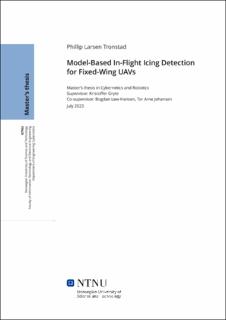| dc.contributor.advisor | Gryte, Kristoffer | |
| dc.contributor.advisor | Løw-Hansen, Bogdan | |
| dc.contributor.advisor | Johansen, Tor Arne | |
| dc.contributor.author | Tronstad, Phillip Larsen | |
| dc.date.accessioned | 2023-11-02T18:20:03Z | |
| dc.date.available | 2023-11-02T18:20:03Z | |
| dc.date.issued | 2023 | |
| dc.identifier | no.ntnu:inspera:140443607:35444110 | |
| dc.identifier.uri | https://hdl.handle.net/11250/3100357 | |
| dc.description.abstract | Det kommersielle markedet har vært vitne til en bemerkelsesverdig økning i
forekomsten av ubemannede fly (UAV-er) i nyere tid. Denne raske veksten
har ført til økende bekymring rundt sikker bruk av UAV-er. Blant de ulike
farene knyttet til bruken av UAV-er, er ising under flygning en trussel som kan
få alvorlige konsekvenser for UAV-ers ytelse og stabilitet. Målet med denne
masteroppgaven er å utvikle en modellbasert metode for å detektere ising på
UAV-er under flyging.
Det første steget i denne prosessen omhandler utformingen av optimal-
iserte eksperimenter der hensikten er å samle data som best beskriver den
laterale og longitudinale dynamikken. Dataen som samles inn, analyseres ved
hjelp av konvensjonelle metoder for systemidentifikasjon av flydynamikk, som
equation-error-metoden og output-error-metoden. Disse metodene anvendes til
å estimere stabilitets- og kontrollderivatene til Skywalker X8 UAV-en, som
modellerer den underliggende dynamikken i nominell og iset tilstand. Til tross
for den primitive sensorpakken ombord på UAV-en og den sterke vinden un-
der flyeksperimentene, resulterte modellene fra equation-error metoden i R2-
verdier på rundt 0,6 sammenliknet med den observerte dynamikken.
Metoden som brukes i denne masteroppgaven kombinerer de identifiserte
modellene av flyet med og uten ising med en multi-modell adaptiv estimer-
ingsstrategi. Denne metoden er drevet av en bank av utvidede Kalman-filtre
(EKF-er) for å detektere og kvantifisere graden av ising under flyging. På grunn
av at UAV-en krasjet og brant opp under forsøket, ble ikke den isede flymodel-
len identifisert. I stedet viste isdeteksjonsmetoden sitt potensial i simuleringer
ved bruk av tidligere identifiserte koeffisienter. Estimatoren var i stand til å
oppdage og kvantifisere isingsnivåer i ulike simulerte flyscenarier under isede
forhold og identifisere riktig alvorlighetsgrad av ising med en gjennomsnittlig
forsinkelse på ca. 5 s. | |
| dc.description.abstract | The commercial market has witnessed a remarkable surge in the prevalence
of small, low-cost unmanned aerial vehicles (UAVs) in recent times. However,
this rapid growth raises a crucial concern: ensuring the safe operation of these
UAVs. Among the various hazards they face, in-flight icing emerges as a signi-
ficant threat that can seriously impact the performance and stability of UAVs.
Consequently, it poses an escalating risk to their overall safety. To address this
issue, the primary objective of this master’s thesis is to devise a cost-effective
and efficient methodology for model-based in-flight icing detection specifically
designed for fixed-wing UAVs.
The research begins with the design of preliminary system identification
experiments optimized for the identification of the dynamics at the dominant
frequencies in the lateral and longitudinal modes. The data gathered is ana-
lyzed by utilizing conventional aircraft system identification algorithms such
as the equation-error method and the output error method. These methods
are designed to identify stability and control derivatives of the Skywalker X8
fixed-wing UAV in order to model its dynamics in normal and icing conditions.
Despite the basic sensor suite and strong winds during the flight experiments,
the equation-error method resulted in models with R2 scores of around 0.6
when compared with the observed dynamics.
The methodology investigated in this thesis combines the identified models
of clean and iced airframes with a multiple-model adaptive estimation frame-
work. This is driven by a bank of extended Kalman filters (EKFs) in order to
detect and quantify the presence of icing in flight. Due to the UAV crashing
during flight experiments, the iced airframe model was not identified. Instead,
the icing detection scheme proved its potential in simulations using other sets
of coefficients. It was able to correctly detect and quantify icing levels in a
selection of simulated scenarios of flight in icing conditions, identifying the
correct icing severity after about 5 s on average. | |
| dc.language | eng | |
| dc.publisher | NTNU | |
| dc.title | Model-Based In-Flight Icing Detection for Fixed-Wing UAVs | |
| dc.type | Master thesis | |
